
Newton Arvin
COUNTERFEIT PRESENTMENTS
Everyone knows-we owe the knowledge to a hundred
travelers and anthropologists-how intensely the "primitive man"
feels on the subject of having his portrait painted or his picture taken
-and how alarmingly he sometimes acts. Is it possible that such
feelings survive in our civilized psyche in some unconfessed and
deeply buried guise? The history of western portrait-painting since
the early Renaissance would hardly suggest such a thought, and just
as little would the prosperous history of the portrait photographer
since the days of Daguerre and Draper. Sir James Frazer tells us that
the Tepehuanes of Mexico were once panic-stricken by the prospect
of having a camera turned on them, and that, when at last they
agreed to pose, it was with the conviction that death or some other
great evil would follow. And indeed he alleges that even in western
Scotland, in the nineteenth century, there were persons who refused
to have their likenesses taken in the fear that such pictures might ruin
their luck or their health. Is the distance between ourselves-con–
temporaries of Steichen and Weston-and the Tepehuanes or the
western Scots so great as we commonly imagine?
Perhaps it is, but if so it is not because we are not, in our own
manner, obsessed with the idea of the portrait. The almost mysterious
formulas which prescribe, in any given age, the recurrence of favorite
words or images in titles, betray this fact. Everyone, surely, has ob–
served how often the very word "portrait" or some word like it has
echoed and re-echoed through the titles of our recent literature. To
go, for the moment, no further backward, it has been a favorite ever
since, in the early eighties, Henry James published
The Portrait of a
Lady.
Walter Pater was close on James's heels, in 1887, with
Im–
aginary Portraits,
and then very quickly came Oscar Wilde with
673


